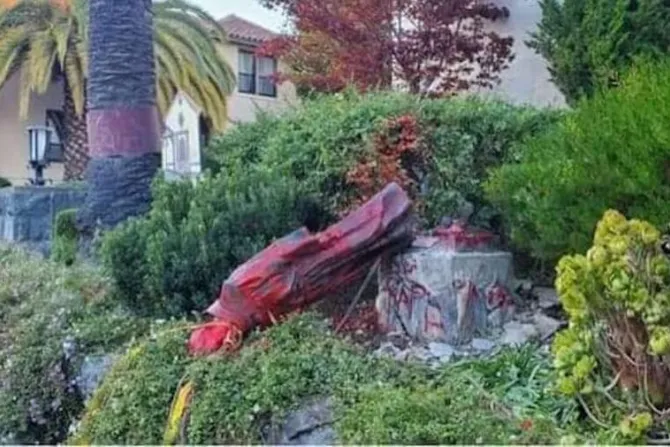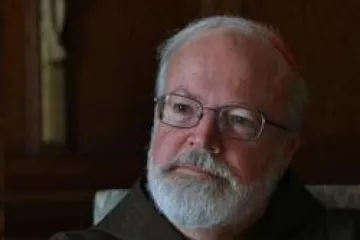Denver, Colo., May 26, 2023 / 13:15 pm
Archbishop Salvatore Cordileone of San Francisco said Thursday that prosecutors’ decision to reduce the charge against activists who destroyed a parish’s statue of a saint from felony to misdemeanor sends the signal that attacks against the Catholic Church can continue with impunity.
“It is clear to me that this course of action would not have been taken with anyone else. In fact, if the same kind of offense had been committed against another religious congregation or group, it would almost certainly have been prosecuted as a hate crime,” Cordileone said.
Cordileone’s statement follows a decision by the the Marin County District Attorney’s Office to reduce charges against five protesters who, on Oct. 12, 2020, defaced and tore down the statue of St. Junipero Serra on the grounds of Mission San Rafael Arcángel, the present-day home of St. Rafael Church in San Rafael, California.
“There have been more than 100 attacks on Catholic Church property across the nation, including in the Archdiocese of San Francisco, one of which was someone firing a bullet into our cathedral. Anti-Catholicism has a long and ugly history in this country.”
“Now, with this decision, the Marin County district attorney has given the signal that attacks on Catholic houses of worship and sacred objects may continue without serious legal consequence,” the archbishop said.
Before the activists attacked the statue, members of the Coast Miwok tribe held a planned hourlong protest to mark Indigenous People’s Day. Numerous statues of the saint were vandalized or destroyed in 2020, most of them in California, amid civil unrest in the wake of the Minneapolis murder of George Floyd, a Black man, by a white police officer.
Dean Hoaglin, chair of the Coast Miwok Tribal Council of Marin, who was not charged in the vandalism, characterized the statue as “a continued reminder of the impact of colonization and genocide of our people,” Fox2 News reported at the time the statue was destroyed.
A reduction in charges
In November 2020 the Marin County District Attorney’s Office filed felony vandalism charges against the five defendants, who now range in age from 25 to 40.
On May 25, the district attorney’s office announced the case has been “resolved through an innovative restorative justice solution.” The felony charges were reduced to misdemeanors.
The defendants must pay monetary restitution to the church to repair or replace the statues, complete 50 hours of volunteer work, apologize in writing, and participate in a community forum with “a credible historian who will give stakeholders a chance to have a meaningful dialogue about the issue.” They must also stay off church property.
“It is the district attorney’s office’s goal to achieve a fair result on all cases, and I strongly believe justice was served on this one,” District Attorney Lori E. Frugoli said Thursday.
“While this issue has raised emotions because of the sensitivities around religion, community boundaries, and historic inequities, the fact is that a resolution through accountability has been reached through restorative justice and that is a victory for this community.”
A defense of St. Junipero Serra
Cordileone, in a May 24 letter to Frugoli’s office, said he has tried to “show goodwill and a desire to pursue a peaceful but honest resolution of this ugly affair.”
“I readily acknowledge, and have done so numerous times, that horrible atrocities have been perpetrated against the indigenous people of California,” he said. “While an honest reading of the historical record would clear Junipero Serra of perpetrating such atrocities — indeed, he gave his life to defending the native people of our land — the actual historical record is beside the point.”
(Story continues below)
Critics of Junipero Serra claim that he and his missions were responsible for a host of atrocities against native peoples. The claim has drawn strong objections from Catholics who say this is inaccurate and misrepresents Serra.
“Junípero Serra spent his life caring for and defending the indigenous people of California to the point of heroic virtue. Indian and Spaniard alike mourned when he died,” Cordileone said in September 2021 after the California governor approved the removal of a Serra statue from state capitol grounds. “We would do well to imitate his virtues. We ignore history to our peril.”
Pope Francis canonized Junipero Serra during his 2015 visit to the U.S. He said the saint “sought to defend the dignity of the native community, to protect it from those who had mistreated and abused it.”
Amid the civil unrest of 2020 in which vandals tore down many statues, there was a massive four-alarm fire at the church at Mission San Gabriel near Los Angeles, which was founded by St. Junipero Serra in 1771. The alleged arsonist, whose trial is still pending, was known at the mission and had a history of conflicts with mission staff.
‘Do you understand the significance of this, and how it makes us feel?’
Cordileone strongly criticized the district attorney’s justification for the reduced misdemeanor charges on the grounds that the perpetrators had shown “active participation” in a “restorative justice process.”
“This point is, a felony crime was committed: The law does not allow people to trespass onto private property and destroy it, all the more so when the private property is a house of worship and the property being destroyed has sacred value to the members of the congregation,” the archbishop said.
Cordileone said he wanted a just punishment for the crime but did not want the defendants to go to prison.
“I have asked that the vandals publicly repudiate their crime and acknowledge the harm they have inflicted on us. Acknowledging wrongdoing is the first step in restorative justice. A simple ‘I’m sorry’ falls pitifully short of reparation for the harm that was done,” he said.
He lamented that San Rafael Police Department officers stood by and watched the vandals commit the crime when the parish had an agreement with the department that the police would intervene if the protesters trespassed onto parish property. Cordileone wondered whether the officers stood by based on orders from their superiors.
“Do you understand the significance of this, and how it makes us feel?” Cordileone asked the district attorney. “Who gave the order to the police officers not to do their sworn duty, for which they put their lives on the line every day? Why has there been no investigation? Why has the person responsible for this injustice not been held accountable?”
Though the district attorney’s office indicated that the resolution to the case followed a “thorough case review” by prosecutors and “a long discussion” among church and community members, Cordileone’s letter indicated the archdiocese was not part of this discussion.
“The archdiocese was shut out of the conversation, and the mediator was treating the perpetrators as if they were the victims,” the archbishop said. He called this “a direct insult to the victims of this crime and only rubs the salt more deeply into our wounds.”
The archbishop cited Americans’ “growing mistrust” in government institutions.
“They perceive, and for good reason, that government officials do not have their best interests at heart but instead make decisions based on what is politically advantageous to them. I regret that when the Marin County District Attorney’s Office had the opportunity to rebuild trust, you instead further undermined it.”
“We will make our voices heard,” said Cordileone, who held an exorcism and offered prayers after the parish’s Junipero Serra statue was torn down.
History of the Mission San Rafael
The San Rafael parish website includes both English and Spanish sections. Its Spanish-speaking community includes people from Mexican, Guatemalan, and Salvadoran backgrounds. Hispanics make up about half of its parishioners.
Though Serra himself did not found Mission San Rafael, it owes its existence to Serra’s legacy, as he founded the first nine missions in what would become California. The mission was founded in December 1817.
According to the parish, the mission was named for the angel of healing and was founded as a hospital for neophyte Native American Christians. It also became an active farm and ranch worked by the Miwok Indians and helped convert 1,873 Native Americans. It served as a mission for only 17 years when the newly independent Mexican government decided to end the mission system and sell the lands to pro-independence Mexican citizens.
The mission fell into ruins. A new parish church was built near the old chapel ruins in 1861 and a replica of the mission chapel was built in 1949.






